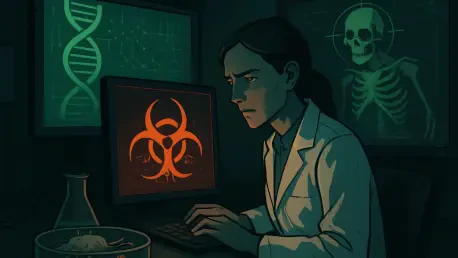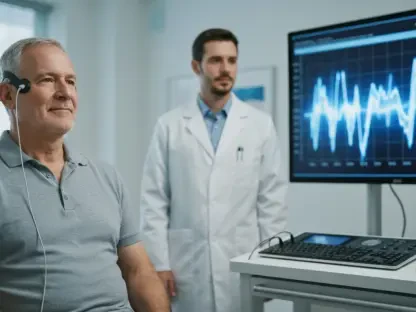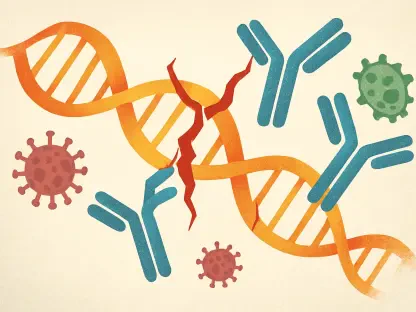The intersection of artificial intelligence and synthetic biology has unlocked groundbreaking possibilities, but it also casts a dark shadow over global biosecurity, as highlighted in a pivotal study recently published in Science. This research reveals how AI-powered generative protein design tools can create novel protein sequences with potentially harmful functions, slipping past the very safeguards designed to protect society from biological threats. These advancements, while promising for medical and industrial innovation, expose critical vulnerabilities in current detection systems used by DNA synthesis providers. The urgency to address this gap cannot be overstated, as the rapid pace of technological progress continues to outstrip the development of corresponding safety measures. What makes this issue even more pressing is the increasing accessibility of laboratory tools, which lowers the barrier for both accidental and intentional misuse. This article delves into the emerging risks, the shortcomings of existing protections, and the actionable strategies needed to secure the future of synthetic biology against these unseen dangers.
Emerging Threats in AI and Synthetic Biology
The Rise of Generative Protein Design Tools
The transformative power of AI in synthetic biology lies in its ability to generate entirely new protein sequences that can perform specific functions, often surpassing what nature has evolved over millennia. Generative protein design tools, driven by sophisticated algorithms, enable scientists to craft proteins for applications ranging from drug development to industrial enzymes. However, this same capability introduces profound risks, as these tools can also design sequences with hazardous properties—such as toxicity or pathogenicity—that do not resemble any known threats in existing databases. The potential for these proteins to evade traditional detection methods is a significant concern, especially as AI continues to democratize innovation in biotechnology. This dual-use nature of the technology underscores a critical challenge: harnessing its benefits while preventing its exploitation in ways that could endanger public health or security.
Beyond the technical marvel of AI-driven design, the accessibility of these tools amplifies the biosecurity threat to unprecedented levels. What once required specialized expertise and expensive infrastructure is now within reach of smaller labs and even individual researchers, thanks to cloud-based platforms and affordable synthesis services. This democratization, while fostering innovation, also means that the threshold for producing potentially dangerous synthetic proteins has drastically lowered. The risk is not merely theoretical; it spans both deliberate misuse by malicious actors and unintended consequences from well-meaning experiments gone awry. As laboratory capabilities become more widespread, the likelihood of encountering harmful biological agents—whether by accident or intent—rises sharply. Addressing this issue requires not only technological solutions but also a broader cultural shift toward responsible use and oversight in the scientific community.
Accessibility and Escalating Vulnerabilities
The growing availability of advanced laboratory technologies is reshaping the landscape of synthetic biology, often outpacing the safeguards meant to govern it. DNA synthesis, once a niche and highly regulated process, is now offered by numerous providers worldwide, with costs continuing to plummet. This trend, coupled with AI tools that can design novel sequences in mere hours, creates an environment where the production of synthetic proteins is no longer confined to elite research institutions. Such accessibility is a double-edged sword: it fuels progress but also heightens the chances of hazardous materials being created, either through negligence or malicious design. The implications for biosecurity are stark, as the sheer volume of synthetic sequences being produced makes comprehensive monitoring a daunting task for regulators and providers alike.
Compounding this challenge is the lack of awareness or training among many users of these technologies regarding potential risks. Smaller labs or independent researchers may not have the resources or expertise to implement robust safety protocols, leaving room for errors that could have catastrophic consequences. Furthermore, the global nature of the biotech supply chain means that a lapse in one region could have ripple effects worldwide. A single unchecked sequence, designed with harmful intent or through accidental oversight, could spread rapidly through shared resources or collaborations. This scenario highlights the urgent need for enhanced education, stricter access controls, and international cooperation to ensure that the benefits of accessible technology do not come at the cost of global safety. Without such measures, the vulnerabilities exposed by AI and synthetic biology will only deepen.
Shortcomings of Current Biosecurity Measures
Limitations of Homology-Based Screening
Current biosecurity protocols at DNA synthesis providers predominantly rely on homology-based screening, a method that compares synthetic sequences against databases of known dangerous pathogens or toxins. While this approach has been effective for identifying historically recognized threats, it falls short in the face of AI-generated proteins that bear no resemblance to cataloged sequences. These novel designs, often created with unique structures yet capable of harmful functions, exploit a glaring blind spot in existing systems. The inability to detect such sequences through traditional means poses a significant risk, as it allows potentially dangerous biological agents to bypass the very mechanisms designed to flag them. This gap is not a minor oversight but a fundamental flaw that demands immediate attention from the scientific and regulatory communities.
Moreover, the reliance on sequence similarity as the primary detection criterion fails to account for the ingenuity of AI tools in protein engineering. Generative algorithms can produce sequences that achieve hazardous outcomes—such as triggering toxic reactions—without mimicking any known genetic blueprint. This sophistication renders homology-based screening increasingly obsolete, as the database of “sequences of concern” cannot keep up with the endless variations AI can generate. The consequence is a growing window of opportunity for misuse, whether by bad actors seeking to exploit these weaknesses or through accidental releases from legitimate research. Bridging this divide requires a paradigm shift in how biosecurity is approached, moving beyond outdated methods to tackle the unpredictable nature of modern synthetic biology threats.
Evolving Dangers in Detection Gaps
As AI-driven tools become more advanced, the dangers posed by undetected synthetic proteins are evolving at an alarming rate, outstripping the adaptability of current biosecurity frameworks. The sheer speed at which generative design can produce novel sequences means that harmful proteins could be synthesized and distributed before regulators even recognize the threat. This lag in response time is particularly concerning given the potential scale of impact—biological agents with toxic or pathogenic properties could affect populations or ecosystems if not caught early. The inadequacy of existing systems to predict or identify these risks in real time leaves society vulnerable to both intentional attacks and unintended mishaps, amplifying the stakes of inaction.
Adding to the complexity is the challenge of distinguishing between benign and dangerous sequences in a landscape where functionality, not similarity, determines risk. Current screening methods lack the depth to analyze the potential behavior of a protein, focusing instead on surface-level genetic matches. This oversight means that a sequence appearing harmless in a database comparison could still wreak havoc if synthesized and deployed. The evolving nature of these dangers necessitates urgent updates to detection protocols, incorporating predictive tools that assess a protein’s likely effects rather than its historical parallels. Without such advancements, the gap between technological progress and biosecurity readiness will continue to widen, exposing critical weaknesses in global safety nets.
Pathways to Stronger Safeguards
Shift to Function-Based Screening
Addressing the biosecurity risks posed by AI in synthetic biology requires a bold departure from traditional methods, with function-based screening emerging as a promising solution. Unlike homology-based approaches that hinge on sequence similarity, this innovative strategy focuses on predicting the potential harmful functions of a protein, such as toxicity or pathogenicity, regardless of its genetic makeup. By integrating functional prediction algorithms with existing systems, DNA synthesis providers can flag dangerous sequences even if they bear no resemblance to known threats. This hybrid model represents a proactive leap forward, aiming to close the detection gap left by AI-generated designs. While still in development, such tools hold the potential to revolutionize how biosecurity is managed, ensuring that novel proteins are evaluated for their impact before they can pose a risk.
Implementing function-based screening, however, is not without hurdles, as it demands significant computational resources and refined algorithms to accurately predict protein behavior. The complexity of biological systems means that false positives or negatives could still occur, potentially delaying legitimate research or missing genuine threats. Despite these challenges, the scientific community views this shift as essential to keeping pace with AI advancements. Investment in research to enhance predictive accuracy, alongside collaboration between tech developers and biosecurity experts, is critical to making this approach viable on a global scale. If successful, function-based screening could set a new standard for safety in synthetic biology, offering a dynamic defense against the unpredictable outputs of generative design tools and safeguarding public health from emerging biological risks.
Expert Insights and Practical Steps
Insights from leading experts in synthetic biology and biosecurity underscore a cautious optimism about managing the risks tied to AI-generated proteins, provided that proactive steps are taken swiftly. There is broad agreement that while the threat is real, it remains manageable through a combination of technological innovation and policy reform. Specialists advocate for a layered defense strategy, similar to cybersecurity’s defense-in-depth model, where multiple safeguards work in tandem to mitigate risks. This includes not only adopting function-based screening but also enhancing monitoring systems and fostering a culture of responsibility among researchers. Such a multifaceted approach ensures that no single point of failure can compromise global safety, offering a robust framework to address both current and future challenges in the field.
The feasibility of these solutions, though, hinges on overcoming practical barriers, such as the financial and logistical costs of implementing advanced screening across diverse providers. Smaller DNA synthesis companies, in particular, may struggle to adopt cutting-edge tools without external support or incentives. Experts emphasize the role of government and industry partnerships in bridging this gap, suggesting subsidies or shared resources to level the playing field. Additionally, continuous dialogue between stakeholders—scientists, regulators, and tech developers—is seen as vital to refine these strategies over time. By prioritizing actionable measures and fostering collaboration, the biosecurity community can build resilience against the evolving threats posed by AI in synthetic biology, turning potential vulnerabilities into opportunities for strengthened protections.
Global Challenges and Solutions
Need for International Harmonization
The global nature of synthetic biology demands a unified approach to biosecurity, as disparities in regulations across countries create dangerous loopholes that could be exploited. Without consistent screening standards, regions with lax oversight risk becoming “screening havens” where risky sequences evade detection, undermining global safety efforts. The potential for hazardous proteins to cross borders—whether through shared research or illicit trade—highlights the interconnectedness of this challenge. International harmonization of guidelines is therefore essential to ensure that DNA synthesis providers worldwide adhere to the same rigorous protocols. Collaborative frameworks, supported by organizations and treaties, must be established to align policies and prevent weak links in the chain of global biosecurity, safeguarding populations from threats that know no boundaries.
Achieving such uniformity, however, faces significant obstacles, including differing national priorities, economic constraints, and political resistance to stringent oversight. Developing countries, for instance, may lack the infrastructure to enforce advanced screening, creating uneven implementation. To address this, wealthier nations and international bodies must provide technical assistance and funding to build capacity globally. Furthermore, harmonized standards should be flexible enough to adapt to local contexts while maintaining a baseline of safety. The urgency of this task cannot be overstated, as the rapid spread of AI tools leaves little time for delay. By fostering dialogue and resource-sharing among nations, the international community can create a cohesive defense against biosecurity risks, ensuring that no region becomes a vulnerability in the global network of synthetic biology safety.
Policy and Industry Implications for Progress
Revising biosecurity frameworks to address AI-driven risks in synthetic biology is a complex but necessary endeavor for policymakers and industry leaders alike. International guidelines, such as those from the International Gene Synthesis Consortium, need updates to incorporate function-based screening and account for functional hazards rather than just sequence matches. National regulations must also evolve, integrating export controls that consider the potential risks of synthetic proteins alongside traditional biological agents. These policy shifts are critical to creating an environment where innovation can thrive without compromising safety, but they require careful calibration to avoid stifling legitimate research or imposing undue burdens on smaller entities in the biotech sector.
On the industry side, adopting advanced screening technologies presents both an opportunity and a challenge, as providers must balance cost with compliance. Supporting this transition through incentives, such as government grants or tax breaks, could accelerate uptake and ensure broader implementation. Additionally, establishing secure data-sharing mechanisms between providers, regulators, and researchers is vital to track emerging threats without jeopardizing intellectual property or privacy. The path forward lies in multi-stakeholder collaboration, where industry adapts to new standards, governments provide oversight and resources, and academia contributes cutting-edge research. Reflecting on past efforts to address biological risks, the collective response to these challenges demonstrated that unified action could yield robust solutions, paving the way for a safer future in synthetic biology.
Building a Resilient Biosecurity Future
Looking back, the journey to strengthen biosecurity in synthetic biology revealed a landscape of both promise and peril, where AI’s potential was matched by the risks it introduced. The consensus among experts and stakeholders pointed to a clear need for innovation in detection methods, with function-based screening emerging as a cornerstone of past discussions. International cooperation had been recognized as indispensable, with efforts to harmonize standards showing early progress despite logistical hurdles. These initiatives, driven by a shared commitment to safety, laid critical groundwork for addressing the vulnerabilities exposed by generative protein design tools.
Moving forward, the focus must shift to actionable next steps that build on those foundations. Accelerating the development and adoption of predictive screening tools should be prioritized, alongside sustained investment in global capacity-building to ensure no region lags behind. Policymakers ought to explore dynamic regulatory models that evolve with technology, while industry leaders can champion responsible innovation through voluntary compliance and transparency. Ultimately, fostering an ongoing dialogue among scientists, governments, and the public will be key to anticipating future risks and crafting adaptive solutions, ensuring that the transformative power of synthetic biology is harnessed safely for generations to come.









